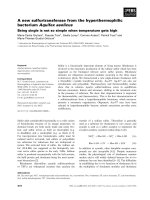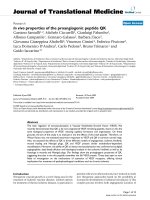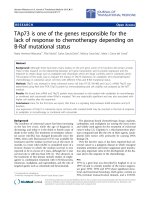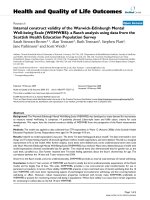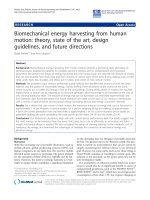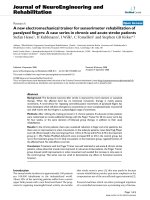báo cáo hóa học:" Anti-inflammatory new coumarin from the Ammi majus L." docx
Bạn đang xem bản rút gọn của tài liệu. Xem và tải ngay bản đầy đủ của tài liệu tại đây (157.31 KB, 18 trang )
This Provisional PDF corresponds to the article as it appeared upon acceptance. Fully formatted
PDF and full text (HTML) versions will be made available soon.
Anti-inflammatory new coumarin from the Ammi majus L.
Organic and Medicinal Chemistry Letters 2012, 2:1 doi:10.1186/2191-2858-2-1
Yasser ABDELAAL Selim ()
Nabil HASSAN Ouf ()
ISSN 2191-2858
Article type Original
Submission date 3 October 2011
Acceptance date 12 January 2012
Publication date 12 January 2012
Article URL />This peer-reviewed article was published immediately upon acceptance. It can be downloaded,
printed and distributed freely for any purposes (see copyright notice below).
For information about publishing your research in Organic and Medicinal Chemistry Letters go to
/>For information about other SpringerOpen publications go to
Organic and Medicinal
Chemistry Letters
© 2012 Selim and Ouf ; licensee Springer.
This is an open access article distributed under the terms of the Creative Commons Attribution License ( />which permits unrestricted use, distribution, and reproduction in any medium, provided the original work is properly cited.
Anti-inflammatory new coumarin from the Ammi majus L.
Yasser Abdelaal Selim
*1
and Nabil Hassan Ouf
2
1
Faculty of Specific Education, Zagazig University, Zagazig, Egypt
2
Chemistry Department, Faculty of Science, Zagazig University, Zagazig,
Egypt
*
Corresponding author:
Email address:
NHO:
Abstract
Investigation of the aerial parts of the Egyptian medicinal plant Ammi
majus L. led to isolation of new coumarin, 6-hydroxy-7-methoxy-10 4
methyl coumarin (2) and 6-hydroxy-7-methoxy coumarin (3); this is the
first time they have been isolated from this plant. The structures of the
compounds (2 & 3) were elucidated by spectroscopic data interpretation
and showed anti-inflammatory and anti-viral activity.
Graphical abstract
An efficient, one-new coumarin (2) was isolated from the aerial parts of the
A. Majus L. was evaluated for their anti-viral and anti-inflammatory
activities.
Keywords: phytochemistry; Ammi majus L.; anti-viral activity; natural
products; anti-inflammatory activity; steroids.
1. Introduction
Fructus Ammi Majoris consists of the dried ripe fruits of Ammi majus L.
(Apiaceae) [1, 2]; originating Egypt, and widely distributed in Europe, the
Mediterranean region, and western Asia, now cultivated in India [2]. This is
widely used for the treatment of skin disorders such as psoriasis and vitiligo
(acquired leukoderma) [1, 3–6], and of vitiligo [1]. It is used as an
emmenagogue to regulate menstruation, as a diuretic, and for treatment of
leprosy, kidney stones, and urinary tract infections [7]. Numerous clinical
trials have assessed the efficacy of Fructus Ammi Majoris andxanthotoxin
for the treatment of vitiligo, psoriasis, and hypopigmentation tinea
versicolor [4–6, 8–11].
2. Results and discussion
2.1. Chemistry
The use of natural products in drug manufacturing is an ancient and well-
established practice [12]. Egyptian medicinal plants are well known by
their diverse uses in traditional folk medicine to cure various ailments
including infectious diseases and known producers of pharmacological and
anti-viral agents [13] A. majus L. is contraindicated in diseases associated
with photosensitivity, cataract, invasive squamous-cell cancer, known
sensitivity to xanthotoxin (psoralens), and in children under the age of
12 years [14]. The fruits are also contraindicated in pregnancy, nursing,
tuberculosis, liver and kidney diseases, human immunodeficiency virus
(HIV) infections and other autoimmune diseases [15]. In this study, the
isolated compounds (2–4) from A. majus L. were evaluated for their anti-
viral activity. The major constituents are furanocoumarins, the principal
compound beingxanthotoxin (methoxsalen, 8-methoxypsorale [8-MOP])
ammoidin; up to, imperatorin (ammid-in) and bergapten (heraclin, majudin,
and 5-methoxy Psoralen [5-MOP]) and other coumarins of significance are
marmesin (the structure of isolated compounds) isoimperatorin, heraclenin,
and isopimpinellin constituents of interest are acetylated flavonoids [16–
20]. The dried plant (500 g) of A. majus L. was sequentially extracted with
hexane and methanol. In our initial biological study as shown in Table 1 the
compounds 2, 3 showed high anti-inflammatory activity while the
compound 4 showed moderate activity. This effect could explain the
medical use of A. majus in traditional medicine. The hexane extract was
chromatographed to give β-sitosterol 1 [21]. The methanol fraction was
chromatographed on silica gel to give new coumarin 2 and two coumarins
3, 4. Compound 2 showed fluorescence under UV indicating it to be
coumarin. The IR spectrum of the compound exhibited the presence of a
carbonyl group at 1710 cm
–1
which was a further support toward the
coumarin nucleus. MS suggested its molecular mass to be 206 in agreement
with the formula C
11
H
10
O
4
, which shows fragments at m/z 193 and 162,
suggesting that fragmentation is occurring in the manner associated with
coumarin nucleus.
1
H NMR of the compound in CDCl
3
showed that no
band was typical of H-4 of a coumarin and singlet at δ 6.25 was assignable
to H-3, indicating that methyl group was attached at position 4. Another
doublet was observed at δ 6.62, which could be H-5 of a coumarin. There
was a singlet at δ 6.43 and 6.82 for two protons which represented H-6 and
H-8 of the nucleus. The
13
C NMR spectrum showed resonance for all 11
carbon atoms in the molecule. The spectra revealed the presence of two
methyl, three methane and six quaternary carbon atoms. The two downfield
quaternary carbon signals at δ, 162.5 (C-3) and 143.7 (C-6) showed the
presence of ketonic and one hydroxyl functionality in the molecule. The
analytical results obtained from
13
C NMR spectrum for this compound was
tabulated in Table 2. Compound 3 showed fluorescence under UV
indicating it to be a coumarin. The IR spectrum of the compound exhibited
the presence of a carbonyl group at 1700 cm
–1
which was a further support
towards the coumarin nucleus. MS suggested its molecular mass to be 192
which agreement with formula C
10
H
8
O
4
.
1
H NMR of the compound in
CDCl
3
showed a doublet at δ 6.72 which was typical of H-4 of a coumarin.
Another doublet was observed at δ 5.35 which could be H-5 of a coumarin.
There was a singlet at δ 6.25 and 6.80 for two protons which represented
H-6 and H-8 of the nucleus. The analytical results obtained from
13
C NMR
spectrum for this compound were tabulated in Table 2. To the best of the
authors’ knowledge, the coumarin compound 3 has not previously been
isolated from this family. The
1
H NMR data of furancoumarin system were
closely similar to compound 4, which included two doublets at δ 6.30 and
8.27 attributed to the pyran ring protons H-3 and H-4, two other doublets at
δ 7.19 and 7.80 corresponding to the furan ring protons H-10 and H-9, and
one olefinic proton at δ 7.20 (s) for H-8. The data proposed compound 4 to
be xanthotoxin [16–20].
2.2. Biological studies
2.2.1. Anti-inflammatory activity
The pharmacological evaluation of the tested compounds (2–4) was carried
out as per the protocol specified. The anti-inflammatory activity of the
synthesized compounds was carried out using the carrageenan-induced rat
paw edema method. The anti-inflammatory activity data for the compounds
are given in Table 1. At the dose level of 0.01 mg/100 g, (2, 3) exhibited
appreciable inhibition of edema, especially 2, which exhibited a 87% of
edema inhibition of 37.81%, which was comparable to that of the standard
drug indomethacin (60.50% at 0.01 mg/100 g dose) where the compound 4
exhibited mild anti-inflammatory activity.
2.2.2. Anti-viral activity
The compounds (2–4) found to have antiviral activity, [13] against
vesicular stomatitis virus (VSV) in a concentration-dependent manner at
complete non-toxic concentration range 10–100 µg/ml (Rf 10(5)), 10–
100 µg/ml (Rf 10(4)), and 50–100 µg/ml (Rf 10(3)), respectively. All these
compounds are found to have no reliable antiviral activity against herpes
simplex virus (HSV).
3. Materials and methods
3.1. General
The
1
H NMR and
13
C NMR spectra were recorded at 270 and 68.5 MHz,
respectively, with TMS as an internal standard using a 270-MHz
JEOLJNM Ex-270/4000 NMR instrument. Optical rotations were
determined on a JASCO P-1020 polarimeter using a 100-mm glass
microcell. IR spectra (KBr) were recorded on a Perkin-Elmer 1650 FT-IR
spectrometer. The UV spectra were recorded with a Perkin-Elmer Lambda
2UV/VIS spectrophotometer. The melting points were determined using a
Digital Melting Point Apparatus (model IA 8103, Electro thermal
Engineering Ltd, Soutthend-on-Sea, Essex, UK). MS were measured on a
GSMS-QP-1000EX gas chromatograph-mass spectrometer SHIMADZU-
Japan. For column chromatography, silica gel (Merk. 63–200 µm particle
size) was used. TLC was carried out with Merk silica gel
60
F
254
Plates. UV
light (245 and 366 mm) and spraying with vanillin–sulfuric acid reagent
followed by heating (120 C) were used for detection.
3.2. Plant material
The aerial parts of the A. Majus L. were obtained from local market, Egypt,
in March 2010. The plant material has been deposited at the Laboratory of
Botany, Faculty of Science, and Zagazig University, Egypt.
3.3. Extraction and isolation
The air-dried plant (500 g) was powdered and extracted with hexane (1.6 l)
at room temperature (25°C) for 30 min, and the hexane solution was
evaporated in vacuo to give a residue (21 g). The methanol extract (32 g)
was obtained by the same procedure. The hexane (20 g) was
chromatographed over silica gel (200 g) using hexane with increasing
amounts of ethyl acetate (5:1) to β-sitosterol (1 C
29
H
50
O). It is crystallized
from methanol (20 mg; from Hexane–EtOAc 9:1, R
f
= 0.22 Light
petroleum: EtOAc 2:1); mp 136°C (literature mp 136–137°C). [22] It
responded to Liebermann-Burchard Reaction. IRν
max
(KBr, cm
–1
) 3427;
1
H
NMR (δ, DMSO), 5.34 (1H, br, H-6), 3.51 (1H, m, H-3), 2.28–1.13 (29H,
m, 11*CH
2
, 7*CH), 0.92 (6H, s, 2*CH
3
), 0.83 (3H, s, CH
3
), 0.80 (3H, s,
CH
3
), 0.78 (3H, s, CH
3
), 0.68 (3H, s, CH
3
); GCMS: 414 (M+). This data
confirmed compound 1 to be β-sitosterol 1 [21] using a direct comparison.
The methanol extract (30 g) was chromatographed on a silica gel column
using successively hexane–ethyl acetates eluent to give three coumarin
compounds (2–4).
3.4. 6-Hydroxy-7-methoxy-4 methyl coumarin (2 C
11
H
10
O
4
)
White, amorphous solid (53 mg; from CH
2
Cl
2
–EtOAc 8:2, R
f
= 0.19 Light
petroleum: EtOAc 2:1); mp 204–206°C; [α]
D
+41.4 (CHCl
3
); UV 218; IR
(KBr) γ
max
3620 (OH) , 1710 (C=O) cm
–1
;
1
H NMR and
13
C NMR, see
Table 2; m/z 206 191(100), 160(17), 143(24); anal. calcd for C
11
H
10
O
4
% C
64.06, % H 4.9, % O 31.3; found % C 64.03, % H 4.21, % O 31.1.
3.5. 6-Hydroxy-7-methoxy-coumarin (3 C
10
H
8
O
4
)
White, amorphous powder (61 mg; from CH
2
Cl
2
–EtOAc 3:1, R
f
= 0.16
Light petroleum: EtOAc 2:1); mp 183–185°C; [α]
D
+46.6 (CHCl
3
); UV
220; IR (KBr) γ
max
3640 (OH), 1700 (C=O);
1
H NMR and
13
C NMR, see
Table 2; m⁄z 192 177(17), 161(100) 144(25); anal. calcd for C
10
H
8
O
4
% C
62.04, % H 4.21, % O 33.2; found % C 61.9, % H 4.43, % O 32.8.
3.6. Xanthotoxin (4 C
12
H
8
O
4
)
White, amorphous powder (26 mg; from CH
2
Cl
2
–EtOAc 1:1); mp 158–
160°C; [α]
D
+46.6 (CHCl
3
). The data from IR (KBr),
1
H NMR and
13
C
NMR proposed that compound 3 is xanthotoxin [16–20]; anal. calcd for
C
12
H
8
O
4
% C 66.64, % H 3.71, % O 29.2; found % C 66.49, % H 3.43, %
O 29.8.
3.7. Biological studies
3.7.1. Anti-inflammatory activity
The anti-inflammatory activity was evaluated by hind paw oedema method.
[23]. Albino rats of weighing 100–150 g, of either three compounds (2–4),
using Indomethacin as a standard, were divided into five groups of six
animals. The animals were maintained under normal environmental
conditions. To each group, with the exception of the control group, the
tested compounds (0.01 mg/100 g of body weight) were administered,
injected. To one group, the standard drug Indomethacin (0.01 mg/100 g)
was administered. After 1 h, carrageenan (0.1 ml, 1% w/v solution in sterile
saline) was injected into the sub-plantar tissue of the left paw of all the
animals. The right paw served as the reference non-inflamed paw for
comparison. The initial paw volume was measured using a plethysmograph
within 30 s of the injection. After 3 h, the final paw volume of each animal
was measured. The percentage of reduction in the paw volume was
calculated by subtracting the difference between the right and left hind paw
volumes in the treated group from the difference in the control group and
dividing it by the difference in the control group. The anti-inflammatory
activity of the tested compounds and the standard reference drug was
determined using the formula, % anti-inflammatory activity = (1 –
V
t
/V
c
) × 100, where V
t
represented the mean increase in paw volume of rats
treated with test compounds and V
c
represented the mean increase in paw
volume in the control group of rats.
3.7.2. Anti-viral activity
In this study, the compounds (2–4) were evaluated for their anti-viral
activity. These compounds were tested against two mammalian viruses,
HSV-1 and VSV. The antiviral activity were determined by means of the
end titration technique that depends on the ability of plant extract dilutions
to inhibit the produced cytopathogenic effect and expressed as reduction
factor (R
f
) of the viral titer.
4. Conclusion
Ammi majus L. being local medicinal plants with great abundance in west
of Egypt are shown in rich in anti-viral and anti-inflammatory activities,
including phytochemicals coumarin.{} These results give them the
privilege to start intensive studies for isolation of these biologically active
compounds for local drug-design programs. In addition, A. majus L. is
considered as a good source of 6-hydroxy-7-methoxy coumarin (3) which
was identified as the major coumarin. Also, this is the first study to report
the occurrence of compound (3).
Competing interests
The authors declare that they have no competing interests.
Acknowledgment
The authors are very grateful to the Botany Department, Faculty of Science
and Pharmacology Department, Faculty of Pharmacy, Zagazig University,
for their help in identification of the plants and farmacological testes.
References
1. Egyptian Pharmacopoeia (1972), vol 2, 3rd edition. General
Organization for Government Printing, Cairo
2. Central Council for Research in Unani Medicine (1987) Standardisation
of single drugs of Unani medicine—Part I. Ministry of Health and
Family Welfare, New Delhi
3. Hakim RE (1969) Rediscovery of a treatment for vitiligo. Clio Medica
4:277–289
4. El-Mofty AM (1948) A preliminary clinical report on the treatment of
leucodermia with Ammi majus Linn. J Egypt Med Assoc 31:651–665
5. Fahmy IR, Abu-Shady H (1948) The isolation and properties of
ammoidin, ammidin and majudin and their effect in the treatment of
leukodermia. Q J Pharm Pharmacol 21:499–503
6. El-Mofty AM (1952) Further study on treatment of leucodermia with
Ammi majus Linn. J R Egypt Med Assoc 35:1–19
7. Farnsworth NR (ed) NAPRALERT database. University of Illinois at
Chicago, Chicago, IL (an online database available directly through the
University of Illinois at Chicago or through the Scientific and Technical
Network (STN) of Chemical Abstracts Services). Accessed 9 February
2001
8. Parrish JA (1974) Photochemotherapy of psoriasis with oral methoxsalen
and long wave ultraviolet light. N Engl J Med 291:1207–1211
9. El-Mofty AM, El-Mofty M (1980) Psoralen photochemotherapy in
contrast to chemotherapy of psoriasis. Med J Cairo Univ 48:71–83
10. El-Mofty AM, El-Sawalhy H, El-Mofty M (1994) Clinical study of a
new preparation of 8-methoxypsoralen in photochemotherapy. Int J
Dermatol 33:588–592
11. El-Mofty AM, El-Sawalhy H, El-Mofty M (1995) Photochemotherapy
in the treatment of post tinea versicolor hypopigmentation. Med J Cairo
Univ 61(4):632–637
12. Yasuhara-Bell J, Yang Y, Barlow R, Trapido-Rosenthal H, Lu Y
(2010) In vitro evaluation of marine-microorganism extracts for anti-viral
activity. Virol J 7:182
13. Soltan MM, Zaki AK (2009) Antimicrobial and antiviral activities of
some Egyptian medicinal plants. J Ethnopharmacol 126(1):102–107
14. Lacy C (2000) Drug information handbook, 6th edition. Lexicomp,
Hudson, OH
15. Wagner H, Wisenauer M (1995) Phytotherapie. [Phytotherapy.] Gustav
Fischer, Stuttgart
16. Abu-Mustafa EA, Fayez MBE (1961) Natural coumarins. I. Marmesin
and marmesinin, further products from the fruits of Ammi majus L. J
Org Chem 26:161–166
17. Hilal SH, Haggag MY (1975) A thin-layer chromatography (TLC)
colorimetric assay of furocoumarins. Egypt J Pharm Sci 16:495–499
18. Abdulla WA (1978) Preliminary studies on the anti-schistosomal effect
of Ammi majus L. Egypt J Bilharziasis 4:19–26
19. Ivie GW (1978) Linear furocoumarins (psoralens) from the seed of
Texas Ammi majus L. (Bishop’s weed). J Agric Food Chem 26:1394–
1403
20. Singab ANB (1998) Acetylated fl avonol triglycosides from Ammi
majus L. Phytochemistry 49:2177–2180
21. Meera M, Kumar S, Kalidhar SB (1999) Phytochemical investigation of
Parkinsonia aculeata. Indian J Pharm Sci 61:315–316
22. Heilbron I, Cook AH, Bunbury HM, Hey DH (1965) Dictionary of
organic compounds. Eyre and Spottiswoode, London
23. Winter CA, Risley EA, Nuss GW (1962) Carrageenan-induced oedema
in hind paw of the rat as an assay for anti-inflammatory drugs. Proc Soc
Exp Biol Med 111:544–547
Table 1. Anti-inflammatory data of the titled coumarin’s compounds
Thickness of rat paw (mm) after Compounds
3 h % Inhibition after 3 h
2
0.43 ± 0.008
b
37.81
3
0.41 ± 0.008
b
36.80
4
0.53 ± 0.009
b
28.17
Indomethacin 0.25 ± 0.1
b
60.50
Control 0.72 ± 0.015 –
The results were significant.
Compared with control (carrogeenin only),
a
p < 0.05
Compared with Indomethacin,
b
p < 0.01
Table 2.
1
H NMR and
13
C NMR chemical shifts (δ/ppm) of (2) and (3)
DMSO-d
6
as the solvents (25°C)
DMSO-d
6
2 3
Position
1
H
13
C
1
H
13
C
1 –
–
–
–
C2(C=O) –
162.5 –
161.8
C3 6.29s
113.2
7.95d
117.05
C4 –
152.6
6.72d
147.3
C5 6.62d
109.3
5.35d
113.4
C6(OH) 6.43d
143.7
6.25d
143.6
C7 – 146.8 – 146.2
C8 6.82d 104.9 6.80d 104.2
C9 – 147.5 – 149.7
C10 – 112.5 – 111.3
C11(CH
3
) 2.45s 19.8 – –
C12(OCH
3
) 3.84s 56.3 3.79s 56.1
